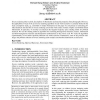Free Online Productivity Tools
i2Speak
i2Symbol
i2OCR
iTex2Img
iWeb2Print
iWeb2Shot
i2Type
iPdf2Split
iPdf2Merge
i2Bopomofo
i2Arabic
i2Style
i2Image
i2PDF
iLatex2Rtf
Sci2ools
WSCG
2004
2004
Inverse Rendering of Polished Materials under Constant Complex Uncontrolled Illumination
Inverse rendering infers realistic descriptions of illumination and material properties from photographs. However, the applicability of state of the art inverse rendering algorithms in real world scenarios is currently limited by the many assumptions made, eg. controlled or simple illumination. In this paper we concentrate on estimating polished materials and describe an inverse rendering system that works under constant complex uncontrolled distant illumination. In particular, we develop an analytical dual angular frequency space shading model for polished materials. We use this shading model in algorithms for estimating homogeneous materials, textures, illumination and both homogeneous materials and illumination simultaneously to the correct scale. We verify the algorithms experimentally in two indoor spectrally different real world scenarios. Furthermore, some of the practical challenges and problems inherent to inverse rendering under complex uncontrolled illumination are discusse...
| Added | 31 Oct 2010 |
| Updated | 31 Oct 2010 |
| Type | Conference |
| Year | 2004 |
| Where | WSCG |
| Authors | Michael Bang Nielsen, Anders Brodersen |
Comments (0)

